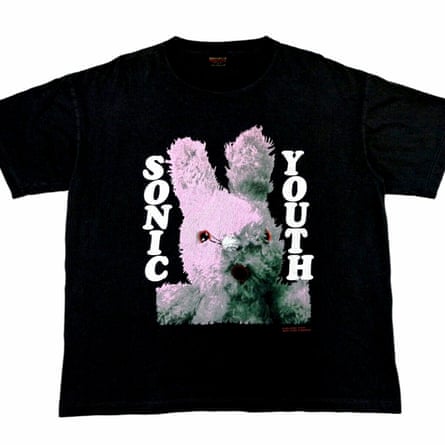When the coveted 1990s graphic T-shirt arrived, the material, cut and stitches looked genuine. Yet Frank Carson, owner of Leisure Centre, a secondhand shop based in Manhattan’s Lower East Side, was suspicious.
In the end it came down to the care tag. One letter that was a “c” should have been an “o”. “That was the only way you could tell it was fake,” he says. “It’s being done with shrewd skill. I had a friend who spent £800 on 10 Akira T-shirts only to find they were all fake.”
In the past few years, the vintage industry has exploded, and rummaging for finds has become big business. Traditionally, a lot of secondhand stock comes from America and “the bins”, where clothes that haven’t sold in thrift shops come out in big trays.
But “digging” is now huge with gen Z on TikTok, and no one is discreet about where they are sourcing things. As thrifting gets harder, fake vintage is on the rise. When a 1992 Sonic Youth T-shirt with a bunny on the front can fetch as much as £2,000 on eBay, selling counterfeit vintage has become a seriously profitable industry.
“Loads of fake stuff is getting into the market,” says Matt Sloane, founder of Jerks, an online secondhand store. “A lot of it is being made abroad.”
All you need is a blank T-shirt modelled on the 90s shape and structure. You can then lift the original artwork, put textured layers over the top to make it look old and wash it many times to fade it. “People get caught out all the time. All the flea markets I go to now have things that are clearly fake, but most people don’t realise,” says Sloane.
Although the practice has been widespread for years, the bootleggers are becoming more savvy. Deeps Samra, owner of online store Catalogue London, says: “It’s not just the most expensive tees being copied – they are delving deeper and doing fakes that consumers wouldn’t realise could be replicated. It’s not just generic band T-shirts – it’s more obscure graphic ones too.”
Things are set to get worse. According to GlobalData, the clothes resale market in the UK is anticipated to grow 39% between 2023 and 2026 to reach £7.2bn. As long as the industry keeps growing and prices continue rising, there is more incentive to make counterfeit goods.
“Even reputable sellers are getting caught out as the calibre of fakes is seriously impressive now,” says Sloane, who receives messages every week to check if something is legitimate. “It’s happening more and more, and you have to be an expert to see the subtle differences.”
Sellers have to stay one step ahead. “We’re forever trying to weed them out; we talk to each other to try and navigate through it,” explains Samra.
Secondhand trader Rory Bruton, who sells at Portobello market in London under the name Dependable Dog, says it can be hard to tell the difference, especially if you are looking online. Telltale signs are the way the tags are made, whether the item has a single stitch hem (which was more common in the 80s) and the weight of the material. “Original vintage shirts have a feel to them that people just can’t replicate,” he says.

Bootleggers are also finding authentic, vintage blank T-shirts to turn into fakes. “They are getting better at fooling people, and even creating vintage items that didn’t exist,” says Carson.
Erin Murphy, owner of Attagirl in London’s Brick Lane, who sources 90s and 00s designer womenswear and handbags from Italy, looks at the stitching, leather and quality.
Harry Sims, owner of Hartex, a vintage sportswear shop on London’s South Bank, says keeping up with the bootleggers can be exhausting. “There’s a lot more fake vintage coming in, and it’s scarily good.” As well as the shine of the thread, the tags are often the giveaway. “We’re catching people out, and our reputations are based on this,” says Sims.
Reselling sites are also doing their bit to crack down: eBay’s authenticity guarantee programme can verify listings such as handbags and trainers and undertakes “rigorous physical inspections”. A spokesperson for eBay UK says they are expanding the service to ensure “people have that extra layer of trust”.
Ultimately, if the item looks too good to be true, then it probably is, especially if multiple sizes are available. “I’m seeing a lot of Vivienne Westwood punk pieces from the late 70s and early 80s, and basically all of them are fake,” says Bruton.
“There’s really not many of them around, as people just wore them to shreds. It wasn’t punk to look after things. I won’t buy unless the person has some kind of connection with it, maybe a photo of themselves from back in the day.”
But does it matter? Do you need the real thing in the first place? If you knowingly wear a fake and it looks good on you and you like it, Bruton thinks that is fine.
Sloane, however, fears that fakes are diluting the legitimacy of the industry. “I don’t have a problem with people willingly buying them,” he says, “but people are being ripped off and losing trust in vintage sellers.”
